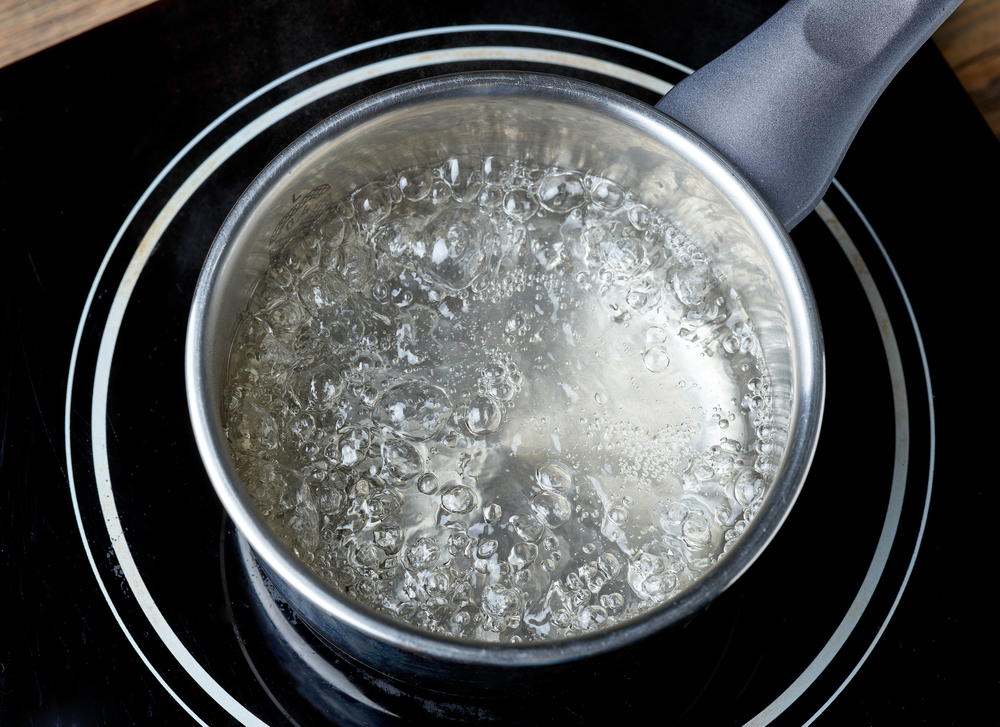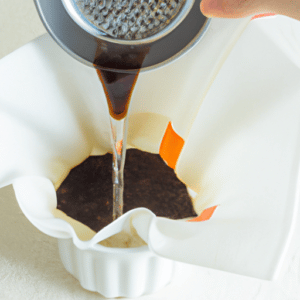We often rely heavily on our gadgets, tools, and appliances in today’s modern world. Things like coffee machines make mundane daily tasks much easier and quicker.
But what happens if your cherished drip coffee maker or bean-to-cup coffee machine malfunctions? Disaster! How are you going to get your morning dose of caffeine until the device is fixed? Don’t worry! In this guide, we look at how to make filter coffee without a machine using three effective methods. Keep reading to find out more!
Method 1: Stovetop Brewing

Stovetop coffee is one of the easiest brewing methods aside from using a coffee maker! It is also a pretty satisfying process and simple to complete.
We describe this method in greater detail below. What’s great is that you don’t even need special equipment to brew coffee using a stove.
You most probably have all the equipment needed to brew coffee on your stovetop.
The items required are listed below:
- Stove or hob
- Ground coffee
- Water
- Saucepan
- Spoon
- Mug
First, place your saucepan on the stove and pour cold water. We advise pouring more water than is needed to brew coffee because some will evaporate when boiling. Next, add your coffee grounds and stir into the water.
You can now turn on the stove and start heating the mixture. Bring the coffee/water mixture to a boil. As it is heating, continue to stir the coffee occasionally to ensure an even consistency and distribution. Once the mixture is boiling, leave it boiling for two minutes more without a covering.
Once fully boiled, turn the heat off and remove the saucepan from the stove. Allow it to sit for several minutes. Once cooled slightly, use a spoon or ladle to scoop the coffee into your mug! The ground coffee beans should have settled at the bottom of the saucepan, making ladling the coffee more accessible.
Pros and Cons of This Method
Stovetop brewing is a simple method to use, but it is not without complications. We have listed the pros and cons below:
Pros:
- One of the easiest methods to do
- It doesn’t take much time
- It doesn’t require any specialist equipment or filters
- Ideal if you are on a camping trip
Cons:
- The lack of a filter can result in some grounds escaping
- It can be tricky to ladle the coffee properly
Method 2: Create a Homemade Coffee Bag

Did you know that you can also use instant coffee granules or ground coffee to create a coffee bag? It is essentially the same as a traditional tea bag. However, instead of tea, the bag is filled with coffee!
This method does require a little specialist equipment, but not much. The main items you need that you may not have handy are coffee filters and string. You can use any type of coffee filter as long as it can be tied to make a teabag. The following is the required equipment:
- Water
- Ground coffee
- String
- Coffee filter or paper filter
- Mug
First, add ground coffee equal to one serving onto the coffee filter. Ideally, you should place the coffee into the centre of the filter. Next, enclose the ground coffee with the paper filter and scrunch it into a ball. Essentially – you need to make a teabag with the filter and coffee. Once you have made the shape, tie the top of the coffee bag using the string.
Ideally, the string should be long enough to tie around the top of the bag but also have an extended piece that you can use to dangle the bag into your mug.
Once you have created your bag and it is secure, place it in your mug. Slowly pour boiling water into the mug and allow the coffee to steep for around five minutes. Once you have your filtered coffee, remove and dispose of the bag.
You can now stir and drink your coffee!
Pros and Cons of This Method
It is quite a satisfying process to create your own bags of coffee! Also, this is generally an excellent brewing method that results in fewer grounds in your drink.
Pros:
- A ` with less ground coffee escaping
- Creates a better brew than the stovetop method
Cons:
- It can be tricky at first to create the bag
- If not appropriately tied and secured, the bag may break
Method 3: Using a Strainer
Lastly, you can take the basic stovetop trick one step further by using a strainer. There are many different types of strainer available. You could use a tea strainer, for example. Alternatively, you could use a sieve. You can use any type of strainer, providing that the holes are small enough to prevent coffee grounds from escaping.
The equipment list is the same as using a stove, with the addition of a strainer.
- Water
- Ground coffee
- Saucepan
- Strainer
- Mug
First, add water and coffee grounds to a saucepan and heat to boiling on the stove. Allow the coffee to boil for two minutes. Once boiled, position the strainer securely over your mug or into a separate saucepan.
Next, pour coffee carefully over the strainer. This strainer method will allow the coffee to filter through without coffee grounds escaping.
You can then either stir and enjoy your coffee, or if you have used a separate small saucepan, pour it carefully into your mug first!
Pros and Cons of This Method
Pros:
- More efficient method than the stovetop method
- This will result in no grounds spilling into your mug
Cons:
- More time-consuming than the simple stovetop method
Tips for Making Coffee Without a Machine
As you can see, there are many methods to make coffee without a coffee maker. You have to be creative, think outside the box, and think about the basic coffee-making requirements. This means that you don’t have to rely on your coffee machine, and if it breaks, you can still get that caffeine boost! To help you further, we have provided some simple tips below.
Safety First – Always Take Care When Using Boiling Water!
Using a coffee appliance can potentially be dangerous. These appliances are electrical and also use hot water. However, the appliances have safety features, and you are far less likely to have issues than using one of the above methods.
Therefore, please take care! Do not rush your coffee brewing. Take your time and handle any boiling water carefully. It is easy to spill, and this can cause serious injuries and burns.
Be Patient – Your First Attempt May Be Awful!
Using a homemade method like one of the above may require trial and error. Don’t expect your first attempt to make the perfect coffee brew! You may have to adjust your method and create several mugs before making good coffee.
Once you have created the perfect brew using one of these methods, it is advisable to make a note of the process you used, like brewing time and the number of coffee beans or ground coffee. You should then easily be able to repeat the brewing process and consistently create delicious coffee.
Create a Clean Working Area and Prepare for a Mess

When using these homemade methods without a coffee maker, the process can be incredibly messy! This is one of the benefits of a machine. Everything is organized, and you have specific chambers and areas for the various items like freshly ground coffee beans and water.
In contrast, you are more likely to make a mess when using a makeshift coffee bag or a fine-mesh strainer.
As a result, you can prepare for this beforehand. Before making coffee, clear a large working area in your kitchen – on your kitchen work surface, for example. Wipe it beforehand. Also, consider placing some paper towels down too. This can help catch any loose coffee beans or coffee grounds. It also helps absorb any water that you may potentially spill.
By doing these simple things, you can reduce the cleaning time afterwards.
Don’t Worry if Some Filter Coffee Escapes
When making coffee using a homemade coffee filter or one of the above methods, the straining may not be 100% effective. This may result in ground coffee escaping and polluting your coffee mug.
You don’t have to worry, though! It is perfectly fine to drink coffee grounds. Obviously, you don’t want your coffee cup to be full of ground coffee, which is generally unpleasant. However, if a few grounds settle in the bottom of your cup, it is still drinkable!
Look After Your Coffee Machine to Avoid these Situations!
If you don’t want to spend time brewing coffee using one of the above methods, you must look after your coffee makers! Maintenance and regular cleaning are essential to ensure your coffee appliance runs smoothly and has excellent longevity.
Firstly, we advise cleaning the machine after each use. The cleaning involved varies depending on the type and model of the machine. However, it is best practice to wipe and clean any parts that have contact with water and coffee. Make sure that these are clean and free from debris and excess coffee grounds. If pipes and chambers get blocked, this can easily cause damage to your machine.
Also, always read the instructions and make sure you have a firm grasp of how the machine works. Using the machine properly is one of the best ways to avoid damage and issues.
Filter Coffee FAQs
Can Filter Coffee Be Made Without a Filter?
Yes! You can drink filter coffee without a filter in a coffee cup. As you can see above, there are many methods to strain the ground coffee and ensure you don’t drink it. You can either use a makeshift strainer or try to make a simple french press using a spoon, for example.
Is It Safe to Eat Coffee Grounds?
Yes, coffee grounds are completely edible and will not cause any harm to humans. However, we advise avoiding eating ground coffee if possible. The taste is incredibly strong, and if you drink ground coffee, it will have a gritty texture that most will find unpleasant.
Can You Make Coffee Filters?
Yes, you can use many different items to make coffee filters. You need to find a material or object with a fine mesh panel – like a strainer or sieve. Something that will allow hot coffee to pour through while trapping the coffee beans or ground coffee.
Can You Make Cold Coffee Using These Methods?
Yes, the methods remain the same. To make cold coffee, you substitute hot water for cold water. When creating cold coffee, bear in mind that the brewing method will take longer because hot water naturally speeds up the release of coffee into the water. In contrast, cold water does not have an immediate effect.
Don’t Despair if Your Coffee Machine Is Out of Commission!
We hope you have found this guide on how to make filter coffee without a machine helpful. While coffee machines are incredibly useful, you can still make delicious filter coffee without one!
You will already have the required tools and accessories in your kitchen in most cases. The stovetop method, the saucepan method and creating coffee bags are all simple things and can also be quite fun!
If you have clarifications about today’s topic or have questions about the coffee-making process in general, don’t hesitate to let us know in the comments. For more kitchen tips and tricks, check out our other easy-to-follow guides.

